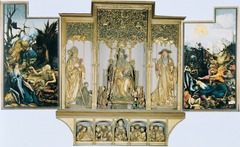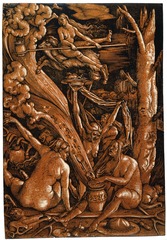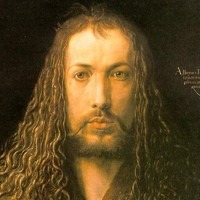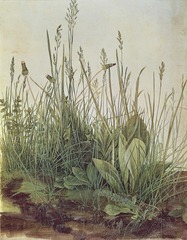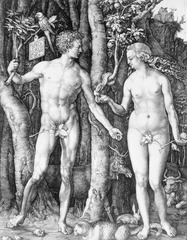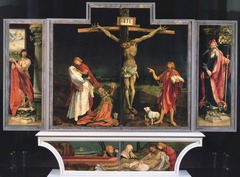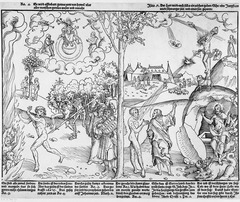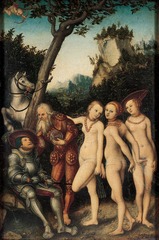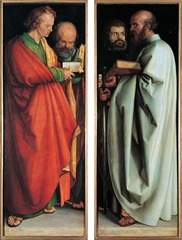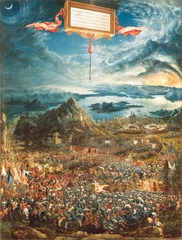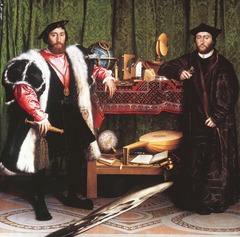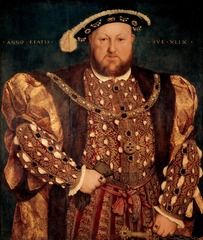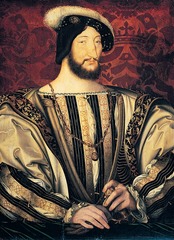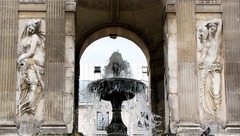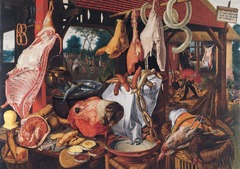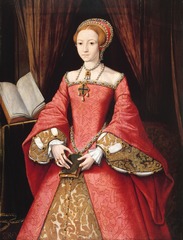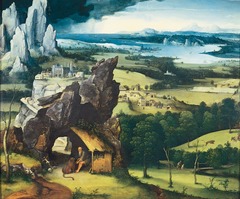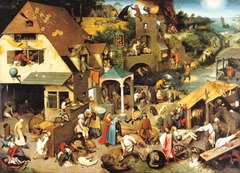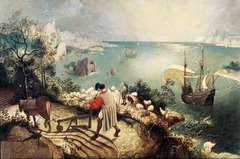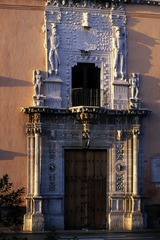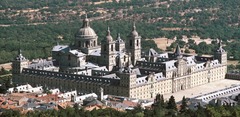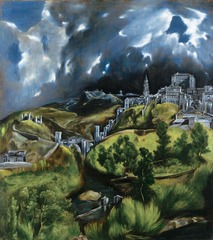Goals
*Understand the consequences of the Protestant Reformation and the Catholic Counter-Reformation
*Understand the diversity of cultures and artistic styles in Spain and Northern Europe
*Identify artists from the 16th century Spain and Northern Europe
Recognize and cite artistic terminology from this period
23.1 Art in the Holy Roman Empire during the 16th Century
* Understand German culture and artistic styles
* Identify representative German artists from the 16th century
* Recognize and cite artistic terminology from this period
Figure 23-2b MATTHIAS GRÜNEWALD, Isenheim Altarpiece (open), from the chapel of the Hospital of Saint Anthony, Isenheim, Germany, ca.1510-1515. Oil on wood, 9′ 9 1/2″ x 10′ 9″, (center panel), 8′ 2 1/2″ x 3′ 1/2″ (each wing), 2′ 5 1/2″ x 11′ 2″ (predella). Shrine carved by Nikolaus Hagenauer in 1490. Painted and gilt limewood, 9′ 9 1/2″ x 10′ 9″. Musée d’Unterlinden, Colmar.
Figure 23-3 HANS BALDUNG GRIEN, Witches’ Sabbath, 1510. Chiaroscuro woodcut, 1′ 2 7/8″ X 10 ¼”. British Museum, London.
23-3A HANS BALDUNG GRIEN, Death and the Maiden, 1509-1511. Oil on wood, 1′ 3 3/4″ X 1′ 3/4″. Kunsthistorisches Museum, Vienna.
Albrecht Durer: “Leonardo of the North”
* Travelled widely through Europe and became an international celebrity
* Took trips to Italy to study Renaissance art
* First artist to synthesize Northern European stylistic features (intricate detail, realistic rendering of objects, symbols hidden as everyday objects) and blend them with Italian features (classical body types, linear perspective) — admired the work of Leonardo
* First artist to keep a thorough record of his life (self-portraits, treatises on his thoughts, and a diary)
* Important graphic artist — best known for his engravings
Influenced significantly by Martin Luther and Protestant Reformation
Figure 23-4A ALBRECHT DÜRER, Great Piece of Turf, 1503. Watercolor, 1′ 3/4″ x 1′ 3/8″. Albertina, Vienna.
Figure 23-5 ALBRECHT DÜRER, The Fall of Man (Adam and Eve), 1504. Engraving, 9 7/8″ x 7 5/8″. Museum of Fine Arts, Boston (centennial gift of Landon T. Clay).
23.2 Protestant Reformation
* Understand the consequences of the Protestant Reformation and the Catholic Counter-Reformation
* Observe how Protestantism affected the role and imagery of art
Figure 23-8 LUCAS CRANACH THE ELDER, Allegory of Law and Grace, ca. 1530. Woodcut, 10 5/8″ x 1′ 3/4″. British Museum, London.
23-9 LUCAS CRANACH THE ELDER, Judgment of Paris, 1530. Oil on wood, 1′ 1 1/2″ X 9 1/2″. Staatliche Kunsthalle, Karlsruhe.
23-6 ALBRECHT DÜRER, Melencolia I, 1514. Engraving, 9 3/8″ X 7 1/2″. Victoria & Albert Museum, London.
Figure 23-7 ALBRECHT DÜRER, Four Apostles, 1526. Oil on wood, each panel 7′ 1″ x 2′ 6″. Alte Pinakothek, Munich
Figure 23-10 ALBRECHT ALTDORFER, The Battle of Issus, 1529. Oil on wood, 5′ 2 1/4″ x 3′ 11 1/4″. Alte Pinakothek, Munich
Figure 23-11 HANS HOLBEIN THE YOUNGER, The French Ambassadors, 1533. Oil and tempera on wood, approx. 6′ 8″ x 6′ 9 1/2″. National Gallery, London.
23-11A HANS HOLBEIN THE YOUNGER, Henry VIII, 1540. Oil on wood, 2′ 8 1/2″ X 2′ 5 1/2″. Galleria Nazionale d’Arte Antica, Rome.
23.3 Art in France during the 16th Century
* Understand the French culture and artistic styles
* Identify representative French artists from the 16th century
* Recognize and cite artistic terminology from this period
Figure 23-12 JEAN CLOUET, Francis I, ca. 1525-1530. Tempera and oil on wood, approx. 3′ 2″ x 2′ 5″. Louvre, Paris.
Figure 23-13 Château de Chambord, Chambord, France, begun 1519.
Figure 23-14 PIERRE LESCOT, west wing of the Cour Carre (Square Court) of the Louvre, Paris, France, begun 1546.
23-14A JEAN GOUJON, Nymphs, from the Fountain of the Innocents, Paris, France, 1547-1549. Marble, each relief 6′ 4 3/4″ X 2′ 4 3/4″. Louvre, Paris.
23.4 Art in the Netherlands during the 16th Century
* Understand Dutch culture and artistic styles
* Identify representative Dutch artists from the 16th century
* Recognize and cite artistic terminology from this period
Figure 23-1 HIERONYMUS BOSCH, Garden of Earthly Delights, 1505-1510. Oil on wood, center panel 7′ 2 5/8″ X 6′ 4 ¾”, each wing 7′ 2 5/8″ X 3′ 2 ¼”. Museo del Prado, Madrid.
Figure 23-15 JAN GOSSAERT Neptune and Amphitrite, ca. 1516. Oil on wood, 6′ 2″ x 4′ 3/4″. Gemäldegalerie, Staatliche Museen, Berlin.
23-15A JAN GOSSAERT, Saint Luke Drawing the Virgin Mary, ca. 1520-1525. Oil on wood, 3′ 7 1/8″ X 2′ 8 1/4″. Kunsthistorisches Museum, Vienna.
Figure 23-16 QUINTEN MASSYS, Money-Changer and His Wife, 1514. Oil on wood, 2′ 3 3/4″ x 2′ 2 3/8″. Louvre, Paris.
Figure 23-17 PIETER AERTSEN, Butcher’s Stall, 1551. Oil on wood, 4′ 3/8″ x 6′ 5 3/4″. Uppsala University Art Collection, Uppsala.
Figure 23-19 Attibuted to LEVINA TEERLINC. Elizabeth I as a Princess, ca. 1559. Oil on wood, 3′ 6 3/4″ x 2′ 8 1/4″. The Royal Collection, Windsor Castle, Windsor, England.
Figure 23-20 JOACHIM PATINIR, Landscape with Saint Jerome, ca. 1520-1524. Oil on wood, 2′ 5 1/8″ x 2′ 11 7/8″. Museo del Prado, Madrid.
Figure 23-21 PIETER BRUEGEL THE ELDER, Netherlandish Proverbs, 1559. Oil on wood, 3′ 10″ x 5′ 4 1/8″. Gemäldegalerie, Staatliche Museen, Berlin.
23-22A PIETER BRUEGEL THE ELDER, Fall of Icarus, ca. 1555-1556. Oil on wood transferred to canvas, 2′ 5″ X 3′ 8 1/8″. Musées Royaux des Beaux-Arts de Belgique, Brussels.
Figure 23-22 PIETER BRUEGEL THE ELDER, Hunters in the Snow, 1565. Oil on wood, approx. 3′ 10 1/8″ x 5′ 3 3/4″. Kunsthistorisches Museum, Vienna.
23.5 Art in Spain during the 16th Century
* Understand Spanish culture and artistic styles
* Identify representative Spanish artists from the 16th century
* Recognize and cite artistic terminology from this period
Figure 23-23 Portal, Colegio de San Gregorio, Valladolid, Spain, ca. 1498.
Figure 23-23A Portal, Casa de Montejo, Merida, Mexico, 1549.
Figure 23-24 Juan de Herrera and Juan Bautista de Toledo, aerial view (looking southeast) of El Escorial, near Madrid, Spain, ca. 1563-1584.
Figure 23-25 EL GRECO, The Burial of Count Orgaz, 1586. Oil on canvas, 16′ x 12′. Santo Tomé, Toledo.
23-26 EL GRECO, View of Toledo, ca. 1610. Oil on canvas, 3′ 11 3/4″ X 3′ 6 3/4″. Metropolitan Museum of Art, New York (H.O. Havemeyer Collection. Bequest of Mrs. H.O. Havemeyer, 1929).
How does art influence or reflect religion?
…
How does Protestant art differ from Catholic art during the Reformation and Counter Reformation?
…
Does religion influence art today? If so, how?
…
How prevalent is religious art today? Why?
…

